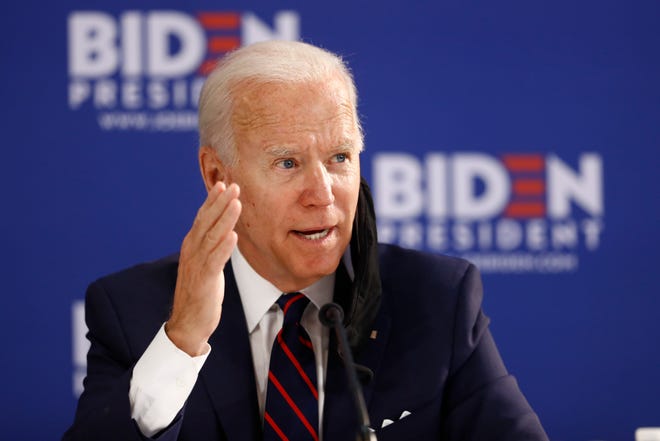The closet radicals are responsible for Joe Biden’s statements that hark back to Bill Clinton’s policy of supporting the Mujahideen in Kashmir.
While the concept of a “fringe” is valid in socio-political analysis, the mistake often made is to regard as equal in significance all segments of the fringe. The religious fringe may be different in its chemistry and interests from the economic fringe, while the political fringe may differ from the cultural outlier. Politicians and their handlers (especially those having fringe elements in their own thinking) frequently confuse the significance of one from the other, thereby either pandering to almost all of them or avoiding getting close to segments that are not at all representative of the mainstream. President Donald Trump seems to be getting ill-served by associates such as Stephen Miller, who had been marinated in the Jeff Sessions School of Confederate Thought before he joined the campaign waged by the US billionaire in the 2016 Presidential polls. As a consequence of this and some other personnel choices, President Trump has in effect adopted a policy of seeking to roll back the tide of non-white numbers within the population of his country. Back in the early 1990s, when a flood of East Europeans came in search of their futures to the US, many were surprised at the (to them) high proportion of non-whites in the US. During a 1992 visit to the US, several young immigrants from the former Soviet bloc expressed their views candidly to this columnist, that there were far too many non-whites in the US, which to them was unexpected and unwelcome. Just as an influx from East Europe may have prodded a shift to the hard right in Israeli politics, certainly the 1990s marked the start of a campaign to reclaim a past where those of European extraction formed the overwhelming majority of US citizens. In this, President Clinton in practice stood on the “right” side, while verbally spouting alternative rhetoric, from his taunt at the impetuous Sister Souljah during the 1992 campaign, to the introduction of prison rules and other measures which criminalised large swathes of the African-American community, much of which nevertheless remains in thrall to the Clintons to this day. Or to his throwing into the waste bin the Taft-Hartley Act in order to benefit Wall Street, which stands by the Clintons to this day.
In 2016, enough US electors voted for Trump in preference to Hillary Clinton to enable him to become the 45th President. Joe Biden does not generate anywhere close to the toxicity that has enveloped the Clintons, whereas the embrace of Confederate social policies has distanced Donald Trump from much of the electorate. It needs to be remembered that many—if not a majority—of those with European extraction (in that continent or elsewhere) have opposed racial supremacy and have welcomed millions of non-white immigrants to their shores, the UK and Germany being among them. Trying to win an election in 2020 on the basis of doctrines that were laid to rest in the 1960s is hardly the best course towards a second term, and unless there is a limited kinetic action with China, the Democratic Party will pick up the White House. Should that party avoid the trap into which Trump rushed head first, of embracing the fringe and forgetting the mainstream, it is likely to prevail in the Senate as well. Unfortunately, Candidate Biden seems to be following in the footsteps of Trump by publicly endorsing positions prepared for him by fringe elements who migrated to his side after the 2016 surrender of Bernie Sanders to the Clinton machine. Many are closet radicals, and they are responsible for statements made by Joe Biden that hark back to Bill Clinton’s policy of supporting the Mujahideen in Kashmir over the interests of those parts of that territory left in India’s control after the 1948 ceasefire and reference to the UN. More than two million Indian-American votes in the November 3 elections are heading Trump’s way simply because of the frequent (fringe-inspired) India-phobic sniping indulged in by the unwary Democratic Party candidate during the campaign. Of course, were a President Biden to embrace China in the UNSC, as the Trump campaign is alleging he would, it may be possible to get discussed some anti-India resolutions in that forum, which till 2022 at least will have the world’s largest democracy as a member. Given the anti-India rants of the Biden campaign when compared to the support of the Trump administration to Delhi in its confrontation with Beijing, it seems obvious as to which side those in the US in favour of close ties between the US and India should vote for. Pandering to the Clintons in the choice of Vice-President (by avoiding choosing Susan Rice, Elizabeth Warren or Kamala Harris as his running mate in favour of a Clinton favourite) and to Ilhan Omar in his attacks on India, Biden may yet prove to be the most effective asset of the Trump campaign, just as Hillary Clinton was in 2016.
Perhaps it is time for Jill Biden to gently tell her husband that India is indispensable for the US and its allies to prevail in the ongoing contest with the PRC over mastery of the Indo-Pacific. And that pandering to the fringe may cost Biden what ought to be a walk-over against Donald Trump in the presidential polls. China and the economy will loom large in the polls, and at least in the case of the first, to take the side of the India haters in the manner Hilal-e-Pakistan awardee Joe Biden is doing is going to cost him and his party at the ballot box.

